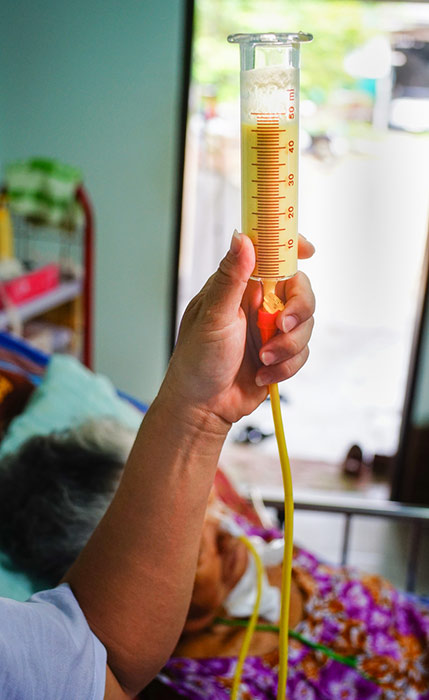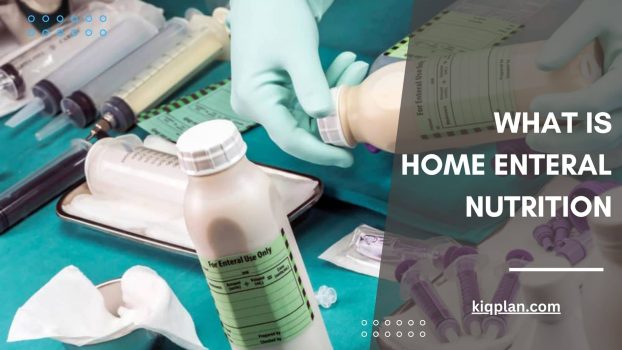Do you have trouble eating due to cancer, stomach or brain issues, or any trauma? If yes, your doctor may suggest you opt for enteral nutrition. But for a layman, the first question is: “What is home enteral nutrition?”
Enteral nutrition, also referred to as tube feeding, is a method that helps send nutrition right to your intestine or stomach. The procedure is helpful for patients who can’t get their required nutrients properly.
Some patients choose to experience tube feeding at their hospital, while others opt for it outside the hospital (called HEN or home enteral nutrition).
Looking for more details? Dig in as we find out about home enteral nutrition in depth.
What Is Home Enteral Nutrition?

Enteral nutrition or tube feeding is a feeding practice to send nutrition right to your small intestine or stomach if you are unable to drink or eat enough. This method works for patients with a stable digestive system but an inability to eat properly.
There are many reasons why you may find it tough to eat or drink.
If you have head or neck cancer, you may have a painful experience eating your food. Similarly, people going through cancer treatments also find it tough to swallow food properly.
Sometimes your brain or spinal cord fails to support your eating. In that case, you may need to shift to tube feeding.
If you suffer from bowel blockage or gastroparesis, your doctor may suggest enteral nutrition to feed your body with the required nutrients.
Finally, enteral nutrition is important for patients suffering from trauma in which they may have suffered from an injury to their digestive tract.
Most patients get tube feeding in hospitals under the care of their doctors and patients.
However, if you are medically stable, your specialist may discharge you back to your residential care or house so you can self-manage your tube feeding regimen. This is called home enteral nutrition.
If you can't self-manage but have family and friends to look after you, the hospital will consider you for home enteral nutrition. For that to happen, your family should be trained to care for you and must be documented as competent people to administer your entire feed plan.
How Does Tube Feeding Work?
Tube feeding or enteral nutrition is a method to supply liquids and nutrients to your body to help you survive. The approach uses feeding tubes that are flexible, soft and made of plastic that help nutrients travel easily via your gastrointestinal tract.
The tube either goes through the nose or directly into your small intestine or stomach. All healthcare providers guide their patients on how to perform enteral nutrition once they are discharged from the hospital.
It is common to get intimidated when getting suggested home enteral by your doctor. There is nothing wrong with getting scared. However, you must know the basics of this approach to ensure that all your worries are handled well.
Think of this tube as an added feature to your digestive system so you can get access to all the required nutrients you cannot swallow normally.
Types of Tubes
Yes, there is more than one type of tube available. The one recommended depends on your needs and your body’s tolerance. The names of a few common tubes are:
Nasogastric Tube: This one travels from your nose to the stomach.
Nasoduodenal Tube: The tube is only made to travel from the nose to just the duodenum, the first part of your small intestine.
Nasojejunal Tube: This tube is designed to travel from the nose to the last part of your small intestine, known as the jejunum.
The above tubes are recommended for those needing them for four to six weeks. If you suffer from a serious sickness and require tube feeding for a long period, you may be suggested the following tubes:
Gastrostomy Tube: This one directly attaches to your stomach.
Jejunostomy Tube: This tube goes to your small intestine’s second part, the jejunum.
Gastrostomy-jejunostomy Tube: The tube goes inside through the stomach and then passes into your small intestine’s second part.
The Experience
The experience to expect depends on the reason for getting tube feeding in the first place. For instance, if you are in a hospital, your healthcare team will take full responsibility, from cleaning the tubes to feeding you.
However, if you are shifted to your house for home enteral nutrition, you or your caregivers may have to get training for each task involved in tube feeding. Additionally, you may require professional help setting up your equipment.
Since this article solely discusses home enteral nutrition, let's dive in to find what you get during this process.
What Happens When You Shift From Hospital To Home for Tube Feeding?
Here is a recap of what is home enteral nutrition. It is a tube feeding method that happens outside the hospital. The place could be your home or a residential care centre.
When shifting you or a patient to a primary care setting, this is the recommended information that is communicated to make the procedure seamless.
Medication, fluid and feed regimen
Method of feed delivery
Aftercare
Tube manufacturer’s guidance
Guidance on any infection control
Contact details of health professionals
If you opt for home enteral feeding, you must receive help from a multi-disciplinary and well-coordinated team. The team may have nutrition nurses, dieticians and therapists on board to simplify this process.
When on home enteral feeding, you can experience different complications. These may include blocked tubes, infections, and gastrointestinal disturbances. To treat them on time, you must have the contact details of all the people looking into your case so you can overcome the issue easily.
Home Enteral Nutrition: Procedure Details
Here are all the details of the procedure you may have to go through during home enteral nutrition.
Inserting the Feeding Tube
It all starts with inserting the tube.
In most cases, healthcare providers insert the tube while you are in the hospital so you can continue using it when you are shifted to your residence. They may insert it nasally, which can happen on your bedside. It is gently inserted into the nose and then moved through the nose, esophagus, and stomach.
Another inserting method is known as endoscopy. Depending on your case, the healthcare provider uses a flexible instrument using a camera to place the feeding tube.
In some cases, doctors insert the tube after taking your x-rays to see where to adjust the feeding tube or worse; they perform surgery to add the tube using laparoscopy.
It is imperative to ask your doctor the approach they want to use to insert the tube into your system. This is helpful so you can prepare yourself.
Once the tube has been successfully inserted, you may be further guided to learn its use.
Using a Feeding Tube at Home
There are tubes that come with pumps or syringes to transfer liquid nutrition from a bag to your body. Some options simply connect the tubes to a bag raised on a hook or pole. These systems use gravity to send the food down to the nose when it's meal time.
Home enteral nutrition or tube feeding may happen during mealtime only. This is called bolus feeding which involves receiving nutrients from your liquid food when you typically want a meal.
However, mealtime feeding usually happens with tubes inserted in the stomach. The stomach can easily handle a large volume of food and store it for a long time.
Alternatively, some patients must be fed continuously through the tube in small amounts. This happens when the feeding tube is inserted in their small intestines, which can’t handle large amounts of food at a time.
Before you are sent home, your healthcare provider will guide you on the food formula you should take to meet your nutritional requirements. Some formulas are designed specifically for patients with diseases like kidney problems.
Plus, while tube feeding, you may also be taught the art of taking home enteral nutrition safely on your first day at home.
For example, you may have to sit at a 45-degree angle while getting fed to prevent a problem like aspiration pneumonia.
Post Feeding Care of the Tube and Your Insertion Site
Now that you know what is home enteral nutrition and the procedure involved, we hope you won't panic when you get suggested this method by your doctor.
But you must know that the feeding method isn't limited to just getting the right nutrients. You should also care for the tube and your insertion site after getting fed to avoid any clogs and infections.
Here are a few things to follow:
Flush your feeding tube using warm water before and after having your food. This is imperative to prevent clogs. Ask your provider to teach you how to clean it.
Change your tube after every few uses so they don't stop performing out of the blue. Keep in touch with your consultant so they can guide you on when to come to get the tube replaced.
Wash the insertion site with a safe mix of soap and water to keep it clean.
Discourage any bacterial growth by drying the site with a cloth after cleaning.
If you see any swelling, redness or pus on the insertion site, immediately alert your doctor.
Conclusion
Understanding what is home enteral nutrition is your first step to adapting to this procedure seamlessly. It may be hard for you to expect this feeding method as an addition to your lifestyle.
However, if nothing else but tube feeding is the last resort left to keep you healthy and alive, don't panic. Just keep your consultant in the loop so you get fed without complications.








